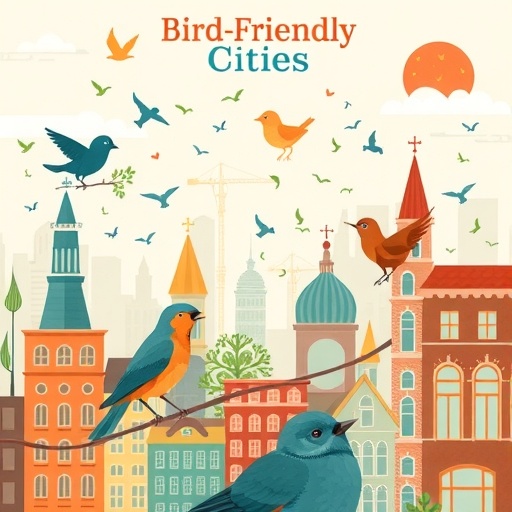Urban landscapes are rapidly evolving, and with them, the intricate relationships between human societies and the wildlife that share the cityscape are becoming increasingly prominent. A groundbreaking study by Goodson, van Riper, and Hauber, recently published in npj Urban Sustainability, presents an insightful exploration into how bird-friendly initiatives, underpinned by the concept of multispecies justice, can transform urban environments. This research not only underscores the importance of environmental stewardship but also heralds a paradigm shift toward embracing ecological coexistence through proactive behavioral change.
.adsslot_DUAibgcVHh{ width:728px !important; height:90px !important; }
@media (max-width:1199px) { .adsslot_DUAibgcVHh{ width:468px !important; height:60px !important; } }
@media (max-width:767px) { .adsslot_DUAibgcVHh{ width:320px !important; height:50px !important; } }
ADVERTISEMENT
Technically, the authors present an in-depth analysis of urban ecological networks, employing cutting-edge spatial mapping and bioacoustic monitoring to quantify bird diversity and activity across differing urban intensities. By integrating citizen science data with advanced machine learning algorithms, they identify critical zones where pro-environmental behaviors yield the most significant benefit. The ability to spatially target interventions enhances resource efficiency and maximizes ecological impact, transforming theoretical principles into scalable solutions.
Environmental psychology features prominently in this discourse. The study illuminates the psychological mechanisms that facilitate or hinder behavioral change, such as empathy toward wildlife, environmental identity, and perceived self-efficacy. It argues for embedding pro-environmental behavior within a culturally resonant narrative that frames birds as urban allies. Campaigns that foster direct engagement with local bird species, such as community birdwatching or school-led stewardship projects, are highlighted as effective catalysts for sustained behavioral commitment.
Importantly, the authors acknowledge the socio-economic variability inherent in urban settings and advocate for inclusive policies that account for disparities in access to green spaces and resources. They challenge the prevalent notion that sustainability is a luxury of affluent neighborhoods, emphasizing the need for equitable distribution of green infrastructure. Through participatory planning processes, underrepresented communities can co-create bird-friendly environments, ensuring that benefits are widespread and justice is embedded at every level of implementation.
Technological innovation is also spotlighted as a powerful enabler. Remote sensing, environmental sensors, and smart city platforms integrated with IoT devices can monitor bird presence and habitat quality in real-time. This data-driven approach empowers municipalities to adaptively manage urban ecosystems, optimizing interventions and engaging residents through transparent feedback loops. The convergence of technology and community participation forms a dynamic system that supports multispecies prosperity.
Education emerges as a pivotal pillar. The authors advocate for curricula that integrate ecological literacy with ethical reasoning, equipping future urban dwellers with the knowledge and motivation to nurture biodiversity. By fostering early-life connections with nature, educational programs lay the foundation for a generational shift in perception—from viewing cities as solely human domains to perceiving them as shared ecosystems. This cognitive transformation is essential for fostering widespread pro-environmental behaviors.
The study also acknowledges significant challenges. Urban densification, conflicting land-use priorities, and limited public awareness pose formidable barriers. However, the authors’ integrative, interdisciplinary approach—melding ecology, urban planning, psychology, and technology—charts a feasible pathway forward. By mobilizing a diverse array of stakeholders, including governments, NGOs, scientists, and citizen groups, bird-friendly cities can become a hallmark of 21st-century urban sustainability.
In conclusion, Goodson, van Riper, and Hauber’s work articulates a visionary yet pragmatic roadmap for transforming urban landscapes into thriving multispecies communities. Their emphasis on pro-environmental behaviors as a linchpin for multispecies justice offers an actionable framework that aligns human aspirations with ecological imperatives. As cities continue to expand, embedding bird-friendly principles into the urban ethos will be critical in safeguarding biodiversity while enhancing human quality of life. This research serves as both a clarion call and a beacon for the global urban sustainability movement.
Subject of Research: Multispecies justice and pro-environmental behaviors fostering bird-friendly urban environments.
Article Title: Fostering bird friendly cities: multispecies justice through pro-environmental behaviors.
Article References: Goodson, D.J., van Riper, C.J. & Hauber, M.E. Fostering bird friendly cities: multispecies justice through pro-environmental behaviors. npj Urban Sustain 5, 33 (2025). https://doi.org/10.1038/s42949-025-00224-w
Image Credits: AI Generated
Tags: avian species conservation strategiesbenefits of urban green spacesbird-friendly urban designcities as habitats for wildlifeecological coexistence initiativesenhancing urban biodiversityenvironmental stewardship practicesethical urban planning frameworksimproving human quality of life through natureintegrating wildlife into city planningmultispecies justice in citiessustainable urban development practices





